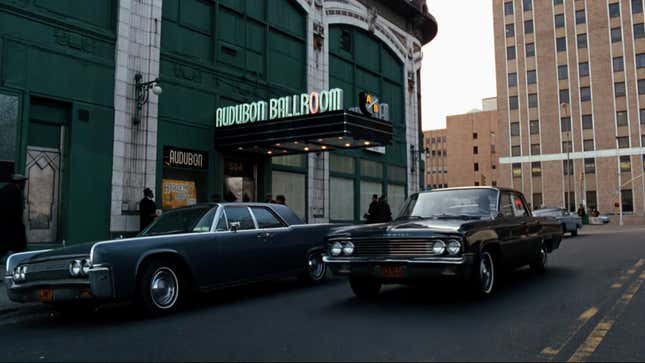
This month marks the 56th anniversary of Malcolm X’s death which means it’s time to rewatch Spike Lee’s seminal 1992 film Malcolm X because it features one of the greatest car scenes in American cinema.
Here’s Malcolm X calmly driving his 1963 Oldsmobile 98 to the Audubon Ballroom.
This is the lead-in to the tragic climax where Malcolm X, played by Denzel Washington, is assassinated by members of the Nation of Islam. Well, I should note that investigations have proposed that the FBI and BOSSI (NYPD) were either aware or implicit in the assassination, and Malcolm X’s family even recently spoke out that the two were behind it. As it is in Spike Lee’s movie, the armed men who share the scene itself shoot Malcolm X as he begins a speech for his newly-founded Organization of Afro-American Unity (OAAU).
It’s powerful; quiet and meditative, but filled with tension throughout. That slow, calm undercurrent of tension is the same as in the backing track: Sam Cooke’s “A Change Is Gonna Come.” Fans of the film will notice that the clip I linked is not directly from Lee’s original work. It’s been edited to emphasize Cooke’s song.
But it makes for a good rewatch because it’s the combination of music and footage that makes it such an arresting and standout moment in a compelling film. Despite the solemn anticipation it’s a calm — if all too brief — moment in time for Malcolm X.
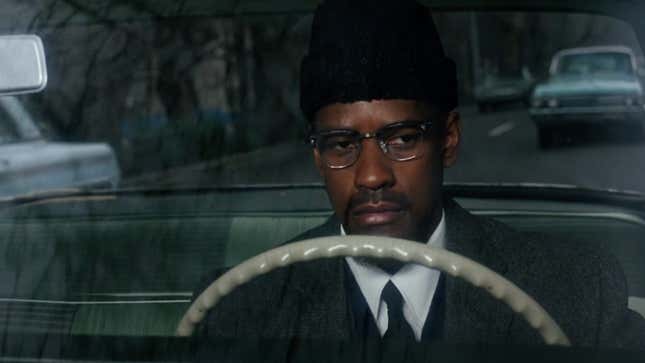
In the Oldsmobile, Malcolm isn’t a revolutionary; he’s just a man lost in thought. From the vantage point the camera offers, that car is a place of reflection. He has space where he can commune with himself, his beliefs and with how those beliefs interact with the world around him. The Olds is not exactly a mosque, but cars can be very spiritual places.
There’s no audible dialogue in the scene, no voice over. Rather than speak, Malcolm is observing. We don’t hear what he’s thinking, but Lee helps us fill it in. We know Malcolm’s worried for his well-being and that of his family. His demeanor expresses vigilance. He seems to be guarded against those that would hurt him but in that car he is safe, a contrast to the world outside.
The camera cuts to the cabins of other cars, which is to say the minds of other characters. They are busy with their own concerns that revolve around Malcolm. His wife, Sister Betty, settles the girls in the backseat of another car while the kids do what kids in cars do. Malcolm’s bodyguard drives them to the ballroom and later escorts them to their place inside. And Malcolm’s would-be assassins watch the rearview mirror in their own car. The rest of the killers ride three abreast in the back with ill-intent on their faces.
When the camera cuts back to the Oldsmobile, Malcolm seems far away. None of those things can touch him. It’s not for a lack of trying. Another driver looks into his car and leers. Malcolm ignores the driver, and keeps his eyes fixed over the road, only glancing away in brief intervals.
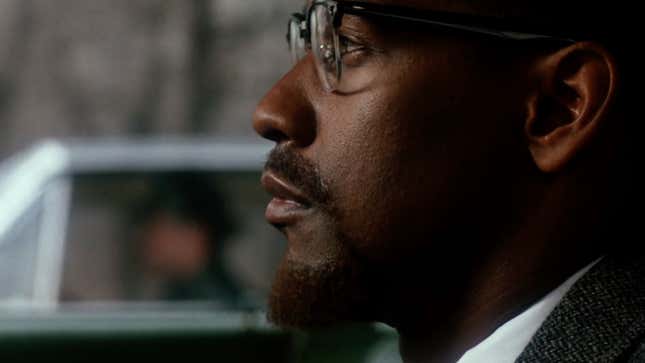
When Malcolm finally arrives to the ballroom and pulls into the parking space there is this poignant image that is so relevant today I think it must boggle Spike Lee’s mind. Then again, maybe not. It could have been exactly what Lee intended.
Right as Malcolm parks, a police cruiser crawls along and the strings in the track swell as Sam Cooke sings, “And I say, ‘Brother, help me please’/But he winds up/ Knockin’ me/ Back down on my knees.” Malcolm is still; he looks forward as the cruiser passes him by.
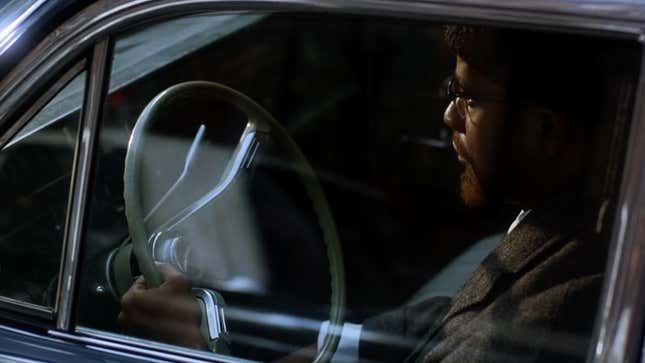
It’s a powerful few minutes of cinema, and a microcosm of the entire film. And it almost didn’t happen. Well, not exactly as we’ve come to know it, because Sam Cooke’s estate famously guards that particular song very much. They don’t lend it out to just anyone. The Chicago Tribune reported on the track being in the film the same year of the film’s release.
Back then, the Tribune wrote that Sam Cooke’s anthem is such an important part of the singer’s legacy that his estate refuses to lend or lease, but Lee was able to convince Cooke’s estate by hand-carrying the filmed scene to their offices and holding a private screening.
The estate could not deny the importance of the song to the scene and they settled with some unusual terms, which is why the song is uncredited in the film. I mention it because drivers know the importance of music to the best and most memorable drives.
Without Cooke’s mournful track, the driving scene just wouldn’t be the same and in turn, neither would the film. The whole thing is familiar to those who find comfort in the soundtrack and solitude of a car’s cabin.
Though, Malcolm’s solitude in the scene is not altogether certain. It does raise the question of the scene’s accuracy. Would Malcolm X have driven to the Audubon by himself that afternoon? Or is it possible that the scene was a dramatization, intended to convey what Lee wanted the audience to feel? Actually, the historical record backs it up.
Alex Haley, who wrote the Autobiography of Malcolm X, described the events as follows:
Sunday morning at nine o’clock, Sister Betty in Long Island was surprised when her husband telephoned her and asked if she felt it would be too much trouble for her to get all of the four children dressed and bring them to the two o’clock meeting that afternoon at the Audubon Ballroom in Harlem. She said, “Of course it won’t!” On Saturday he had told her that she couldn’t come to the meeting. He said to her, “You know what happened an hour ago? Exactly at eight o’clock, the phone woke me up. Some man said, ‘Wake up, brother’ and hung up.” Malcolm X said good-bye to Sister Betty.
And four hours later, Malcolm X left his room and took an elevator down to the lobby, where he checked out. He got his car and in the clear, warm midday of Sunday, February 21, he drove uptown to the Audubon Ballroom.
The film follows that description to a tee.
And you get the sense from reading about Malcolm X that his Oldsmobile meant a great deal to him. Haley recalled Malcom’s unsettling demeanor when Haley tried to light a cigarette inside the car only for Malcolm to remark, “That would make you the first person ever to smoke in this automobile.”
I can almost see Malcolm addressing Haley without even looking at him, his eyes fixed on the road as the unlit cigarette hangs loosely in Haley’s mouth.
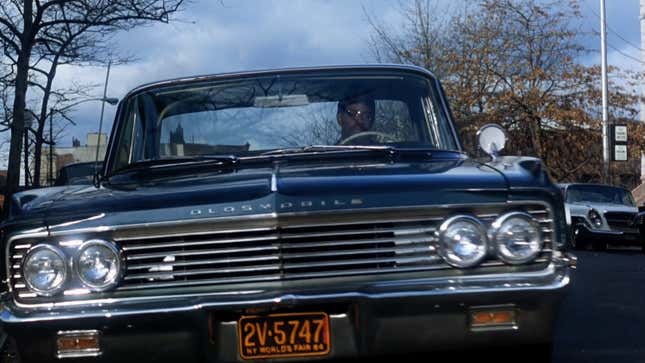
And the Oldsmobile figures prominently throughout the Autobiography’s Epilogue. It’s either in scenes, or is the setting of key exchanges between the two men. The Oldsmobile sat outside Haley’s studio on those late nights Malcolm would visit to work on the autobiography. And the Olds was there when Haley finally saw Malcolm after that year abroad during which Malcolm X made his pilgrimage to Mecca. It was after this trip that he began calling himself “El-Hajj Malik El-Shabazz.”
Sadly, the (dark) blue ‘Olds was part of the setting of their last farewell, too, as Autobiography of Malcolm X describes:
In a happier area, we talked about the coming baby. We laughed about the four girls in a row already. “This one will be the boy,” he said. He beamed, “If not, the next one!” When I said it was close to time for my plane to leave, he said he had to be getting on, too. I said, “Give my best to Sister Betty,” he said that he would, we shook hands and I got outside and stood as he backed the blue Oldsmobile from its parking space. I called out “See you!” and we waved as he started driving away. There was no way to know that it was the last time I would see him alive.
That Oldsmobile may have been where Malcolm could escape from the turmoil of the world, a small isolated space that isn’t all that different from the jail cells where we see Malcolm earlier in the film. And Spike Lee’s retelling of Malcolm’s life shows how Malcolm X changed throughout, but it always comes back to him as a person. Moments like this scene humanize him and reveal a side we seldom see. It reveals his calmness and his concern, and his being in the world while being apart from it.
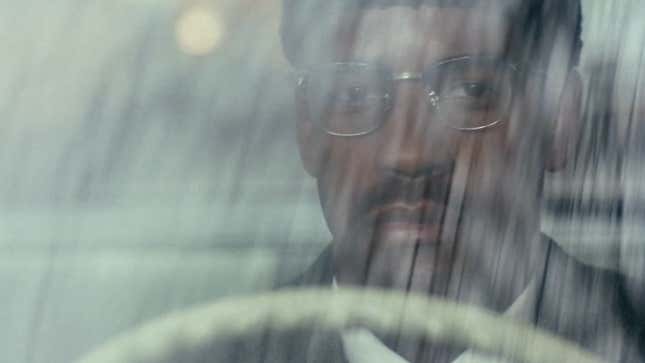
There are enough accounts of the Oldsmobile 98 and Malcolm X together that the car and driver start to become integrated into the story of the icon, enough that Spike Lee’s film would feel incomplete without that driving scene. It makes sense that Malcolm would have driven in silence and solitude that day.
Or even if it weren’t true for that specific drive, there seem to be countless others during which Malcolm X would have been alone with his thoughts in the cabin of his Olds. Whatever the drive was, I like to think that Malcolm derived comfort from that car, which is now on display at the New Malcolm X College and School of Health Sciences after Sister Betty donated it to the school in honor of her husband.
Watching that film and that scene you wish Malcolm X wouldn’t have left the car at all. You almost wish he’d have not stepped into the Audubon that day, and instead just kept driving.